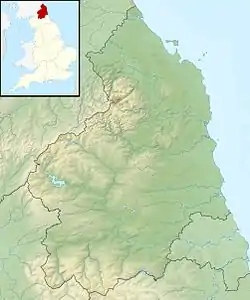River Rede
The Rede is a river in Northumberland, England. The river rises on Carter Fell on the Anglo-Scottish border feeding Catcleugh Reservoir and joins the River North Tyne below the village of Redesmouth. The Rede is one of only two rivers in the North East of England that has the freshwater pearl mussel in its waters.
| River Rede | |
|---|---|
 The River Rede | |
 Location of the mouth within Northumberland | |
| Location | |
| Country | United Kingdom |
| County | Northumberland |
| Physical characteristics | |
| Source | |
| • coordinates | 55.343°N 2.467°W |
| Mouth | |
• coordinates | 55.13204°N 2.22147°W |
| Length | 32 miles (52 km) |
| Basin features | |
| River system | River Tyne |
Course and toponymy
The source of the river is on Carter Fell, part of the Whitelee National Nature Reserve.[1] It flows in a south-easterly direction and is the main feeder for the Catcleugh Reservoir which was impounded in 1901 and completed in 1905.[2] It flows south east through Redesdale alongside the A68 road[3] before meeting with the Otter Burn in Otterburn and heading south, before turning west at East and West Woodburn. It then heads south through Redesmouth before emptying into the River North Tyne.[4]
The name of the river derives from the Old English Rēade, meaning the red one. The river lends its name to Redesmouth, the point where the mouth is.[5]
Catchment and hydrometry
The river measures 32 miles (52 km) from source to Redesmouth and drains an area of 60 square miles (156 km2).[6][7][8] In the upper reaches, the catchment is mostly upland and is partly in the Kielder Forest Park. In the lower reaches, the landscape changes slightly to grassland and upland heath with underlying boulder clay, alluvium and peat.[9][10]
Wildlife
The Rede is known for its salmon, trout and otter, which are commonly seen within its waters.[11][12] The river is notable for being one of the few places in England to have a freshwater pearl mussel population, which in 2006, was estimated at 50,000 mussels across the Rede and the North Tyne.[13] Several projects have been undertaken to help the mussel population including limiting sediment flow in the river and the introduction of freshwater trout into the river.[13] Previously, water that was piped from Catcleugh Reservoir to Whittle Dene Reservoir (at Harlow Hill), was cleaned annual of its harmless sediment, but the waste water was pumped into the Rede. A remedial programme costing £500,000 was implemented in 2019 to stop this from happening.[14]
The use of trout, of which 11,000 were released in 2011, is to help with the pearl mussel's life cycle. The fish were bred at the Kielder hatchery and had microscopic pearl mussel larvae attached to their gills.[15] The programme is hopeful for repopulating parts of the river with new mussels.[16]
Tributaries
The River Rede is the principal tributary of the North Tyne,[17] but the watercourses listed below are the main tributaries of the River Rede
- Bateinghope Burn (r)
- Coomsden Burn (r)
- Ramsden Burn (l)
- Chattlehope Burn (r)
- Cottonshope Burn (l)
- Blakehope Burn (r)
- Bellshiel Burn (l)
- Sills Burn (l)
- Rattenraw Burn (r)
- Durtrees Burn (l)
- Dargues Burn (r)
- Otter Burn (l)
- Raylees Burn (l)
- Miller Burn (r)
- Brigg Burn (r)
- Lisles Burn (l)
- Chesterhope Burn (l)
- Broomhope Burn (l)[4]
See also
References
- "The River Rede's Journey". revitalisingredesdale.org.uk. Retrieved 5 March 2020.
- Historic England. "Catcleugh Reservoir (1464461)". PastScape. Retrieved 5 March 2020.
- Border Moors and Forests. Natural England. 2013. p. 5. ISBN 978-1-78367-024-6.
- "OL42" (Map). Kielder Water & Forest. 1:25,000. Explorer. Ordnance Survey. 2015. ISBN 9780319242810.
- Ekwall, Eilert (1947). The concise Oxford dictionary of English place-names (3 ed.). Oxford: Clarendon Press. p. 365. OCLC 12542596.
- "Download Water Body as CSV / GeoJSONOverall classification for 2016 Moderate Rede from Source to Cottonshope Burn". environment.data.gov.uk. Retrieved 5 March 2020.
- "Rede from Cottonshope Burn to Bellshiel Burn". environment.data.gov.uk. Retrieved 5 March 2020.
- "Rede from Bellshiel Burn to N Tyne". environment.data.gov.uk. Retrieved 5 March 2020.
- "23008 - Rede at Rede Bridge". National River Flow Archive. Retrieved 5 March 2020.
- "23033 - Rede at Otterburn". National River Flow Archive. Retrieved 5 March 2020.
- "The River Rede". revitalisingredesdale.org.uk. Retrieved 5 March 2020.
- Hall, Gemma (2015). Northumberland : local, characterful guides to Britain's special places (1 ed.). Chalfont St Peter: Bradt. p. 179. ISBN 978-1-84162-866-0.
- Gosselin, Marie-Pierre (January 2015). "Conservation of the freshwater pearl mussel (Margaritifera margaritifera) in the river Rede, UK: Identification of instream indicators for catchment-scale issues". Limnologica. 50: 58–66. doi:10.1016/j.limno.2014.12.004.
- Edgar, Bill (26 June 2019). "£500,000 river improvement planned". Hexham Courant. Retrieved 5 March 2020.
- Henderson, Tony (9 December 2011). "Fish released into River Rede to help pearl mussels - The Journal". The Journal. Retrieved 5 March 2020.
- "River sees return of rare mussels". BBC News. 11 December 2011. Retrieved 5 March 2020.
- Border Moors and Forests. Natural England. 2013. p. 7. ISBN 978-1-78367-024-6.
External links
| Wikimedia Commons has media related to River Rede. |